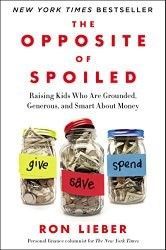Article
Teaching Children About Money Management
Author(s):
It could be a dull subject, but someone has to teach children about money. Ideally, that someone is a parent or both parents. Now, though, they have help.

It could be a dull subject, but someone has to do it. Ideally, that someone is a parent or both parents. Now, though, they have help.
Ron Lieber, a financial columnist for The New York Times, has written a book entitled, “The Opposite of Spoiled.” In it, he gives a prescription for parents to use when teaching their children how to be good stewards of their money.

The initiation starts with 3 jars. When a child is given an allowance, she is asked to divide it equally between the 3 when she is young. One is for spending, one is for saving, and the other is for giving. As the child becomes older, she has the choice of how much to put in each jar. It need not be divided one-third, one-third, and one-third any longer. If she sees the need to spend money for an item she feels she needs or wants (that is blessed by her parents) she can put more in her spending jar. For example, she might want a new bike or a special Halloween costume that her parents’ deem too expensive for their own budget.
Lieber advocates a weekly allowance of 50 cents to $1 per year of age of the child, starting with kindergarten and increased each birthday. He does not support paying children separately for chores.
The containers used for the division of the allowance, he says, should be clear. This is so that the child can actually see the saving and giving portions increasing in quantity. At some point, of course, the giving part may be depleted for whatever charity the child decides to support. Hopefully, not so, the saving.
As to giving, parents can help by introducing children to various charitable opportunities that might interest them, for example an animal shelter or children’s home. This provides occasions for parents and child to meaningfully interact toward a common goal.
The sum and substance of this method is that the child learns to be a caretaker of her own money with the guidance of her parents. Child and parents communicate with one another about the purpose of the jars and together see the contents grow or diminish. This can engender valuable discussion between child and parents. Cleverly, the mother and father can also teach the children about an extra benefit of saving if they pay their offspring interest on her money in her saving jar, thereby teaching that money can grow, even without adding to it.
Is the book worth the read? This is the tally on Amazon.com: 44 readers to date gave it a “5 Star” rating. Eight rated it a “4 Star.” There are no lower ratings. The book is $13.49 on Amazon Prime and can be ordered as a Kindle edition for $14.99. A paragraph on the back cover says it all.
“We may not realize it, but children are hyperaware of money. They have scores of questions about its nuances that parents often don't answer, or know how to answer well… When parents avoid these conversations, they lose a tremendous opportunity—not just to model important financial behaviors, but also to imprint lessons about what their family cares about most.”




